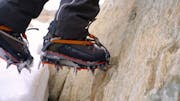Severin Karrer
For a tour over a glacier or in the mountains, you need sturdy hiking boots or mountaineering boots. The crampons you can fit vary depending on the model. Sales Consultant Samuel explains the differences in the video.
Regular hiking boots are unlikely to be up to the task when you’re trekking over glaciers, wending your way through scree or climbing on rocks and ice. Instead, mountain boots will give you the grip you need. Robust hiking boots can also be used with crampons, depending on the model, but it’s generally worth buying mountain boots. It’s easiest to affix crampons to mountain boots and they offer the safest grip.
Alpine touring equipment
Different kinds of mountain boots
Mountain boots have a very robust sole to ensure you can walk safely on snow or wet ground. If the shoes are crampon-compliant, you’ll notice this on the rear portion of the sole. There, you’ll see an indent where you can affix your crampon. In that case, the shoes are crampon-compliant under certain conditions. For fully crampon-compliant footwear, there’ll also be an indent at the front, near the toes. In addition, the soles will have hard edges to give you a firm grip, even on scree.
As with hiking boots, mountain boots also come in a wide range of materials. Most are made from GORE-TEX®, leather or a combination of the two. Depending on the tour, you might be more concerned about the weight of your shoes. However, dry feet are always a bonus. And Alpine tours, in particular, often take you over glaciers. GORE-TEX® is perfect if you’re going to be walking through snow for extended periods and want to keep weight low. Leather’s advantages include its ability to allow moisture to escape.
The right crampons for your tour
Crampons are also made of all kinds of materials. Steel crampons are somewhat more stable and offer good grip on rocky surfaces, while aluminium crampons are lighter but less stable. In short, the best crampons for you depend on the tour you’ll be doing.
The shape of the spikes is also governed by your tour. Vertical spikes pointing downwards from your foot are best for gradients of up to 35 degrees. If you need to climb, front spikes are required: you push them into the ice like an ice pick.
It’s crucial that you pack your crampons properly, which is why special transport bags are available to prevent the spikes from damaging fabrics and stopping you and others from injuring yourself on them. Generally, your crampons will be wet and dirty after a tour. You’re best cleaning them at home and leaving them to dry.
Of course, your feet aren’t the only thing to consider. It’s also important to plan the right clothing for your Alpine tour. Ideally, you should dress in layers to protect you against wind, cold and bad weather.
How to attach crampons to shoes
Depending on the model and brand, there are different ways to attach crampons to your shoes Here’s how the most common ones work:
There is a left and a right crampon. You can tell which one is which by the connection between the heel and toe. This bar should curve outwards. You also can tell by the buckle of the strap. The buckle should always be on the outside of the shoe.
Adjust the length of the crampons to match the shoe. The shoe should be flush with the crampon at the front and back.
To attach the crampon to your shoe, thread the strap through the opening of the toe basket, then through the opening of the back basket, then over the instep to the buckle at the front. At the buckle, thread the strap through both loops and back over the longer one, then tighten securely.
Either tuck the excess strap in the top of your shoe or shorten it with fasteners, for example, through the front basket, so that you don’t trip over it.
Share the articleCrampons for hiking boots and mountaineering boots: what you should look out for
- Free shipping from CHF 99
(With the TransaCard always free of charge)
- Secure payment with Twint, Visa and more
- 14 days cancellation right









































